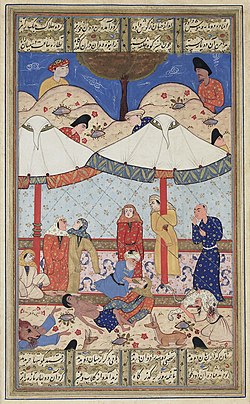Leila och Majnun

Leila och Majnun (arabiska: مجنون ليلى Majnūn Laylā, 'Laylas galna älskare'; [1] ) (persiska: لیلی و مجنون, Leylā va Majnun, 'Leyla och Majnun') är ett av den persiska poeten Nizami Ganjavis mest kända verk, vilket baserats på en gammal historia om den arabiska 600-talspoeten Qays ibn al-Mulawwah och hans kärlek Layla bint Mahdi (senare känd som Layla al-Aamiriya).[2][3][4]
Poesi och prosa med temat Leila och Majnun har återberättats i arabiska, persiska, turkiska och indiska litterära verk[5], genom dikten med samma namn, som skrevs av den persiska poeten Nizami Ganjavi 584/1188, som den tredje delen av hans Khamsa.[4][6][7][8][a] Det är en populär dikt som berömmer deras kärlekshistoria.[9][10][11] Lord Byron kallade det för Romeo och Julia i mellanöstern.[12]
I populärkultur
- Berättelsen och namnet "Layla" var Eric Claptons inspiration till Derek och Dominos berömda album Layla and Other Assorted Love Songs samt dess titelspår från 1971. Låten "I Am Yours" är ett direkt citat från en del i Layla och Majnun.
Källor
Noter
- ^ Nizamis tragiska romans Khosrow och Shirin är en annan del av Khamsan.
Referenser
- ^ Banipal: Magazine of Modern Iran Literature. https://books.google.com/books?id=ykdjAAAAMAAJ
- ^ Schimmel. A Two-Colored Brocade: The Imagery of Persian Poetry
- ^ The Islamic Review & Arab Affairs. https://books.google.com/books?id=rOlHjFjiOJIC
- ^ [a b] A. A. Seyed-Gohrab. ”LEYLI O MAJNUN – Encyclopaedia Iranica” (på engelska). www.iranicaonline.org. http://www.iranicaonline.org/articles/leyli-o-majnun-narrative-poem.
- ^ The Posthumous career of Manuel Puig. https://books.google.com/books?id=X_hIAAAAYAAJ
- ^ Bruijn (på engelska). General Introduction to Persian Literature: A History of Persian Literature. https://books.google.com/books?id=3E8LAQAAMAAJ&q=Layla+Majnun+%22arabic+story%22
- ^ PhD (på engelska). The Complete Idiot's Guide to World Mythology. https://books.google.com/books?id=UYdGl8XM8L0C&q=Layla+Majnun+%22arabic+story%22&pg=PA110
- ^ Grose (på engelska). No More Silly Love Songs: A Realist's Guide To Romance. https://books.google.com/books?id=XoX2r08TGkkC&q=%22arabic+story%22&pg=PT91
- ^ ”أدب .. الموسوعة العالمية للشعر العربي قيس بن الملوح (مجنون ليلى)”. adab.com. Arkiverad från originalet den 8 juli 2017. https://web.archive.org/web/20170708143814/http://www.adab.com/modules.php?name=Sh3er&doWhat=lsq&shid=293&start=0. Läst 4 september 2021.
- ^ al-hakawati.net/arabic/Civilizations/diwanindex2a4.pdf
- ^ ”Visions of Azerbaijan Magazine ::: Nizami - Poet for all humanity”. http://www.visions.az/en/news/271/a3e8bd5c/.
- ^ Byron. ”The Giaour, a fragment of a Turkish tale”. https://archive.org/details/giaourfragmentof00byrouoft.
Fortsatt läsning
- Nizami, The Story of Layla & Majpoonun, ISBN 0-930872-52-5
- Nizami and Colin Turner, Layla and Majnun, ISBN 1-85782-161-0
Media som används på denna webbplats
“The fainting of Laylah and Majnun”
This folio depicts a well-known passage from the tragic story of Layla and Majnun described in the third book of Nizami's "Khamsah" (Quintet). Forcibly separated by their respective tribes' animosity, forced marriage, and years of exile into the wilderness, these two ill-fated lovers meet again for the last time before their deaths thanks to the intervention of Majnun's elderly messenger. Upon seeing each other in a palm-grove immediately outside of Laylah's camp, they faint of extreme passion and pain. The old man attempts to revive the lovers, while the wild animals protective of Majnun ("The King of Wilderness") attack unwanted intruders.
The location and time of the narrative is hinted at by the two tents dressed in the middleground and the dark nighttime sky in the background. The composition's style and hues are typical of paintings made in the city of Shiraz during the second half of the 16th century. Many manuscripts at this time were produced for the domestic market and international export, rather than by royal commission.
This particular painting appears to have been executed at the same time as the text of the "Khamsah" proper, which survives on the painting's verso.
Script: nasta'liq
Dimensions of Painting: Recto: 12.2 (w) x 16.7 (h) cm
